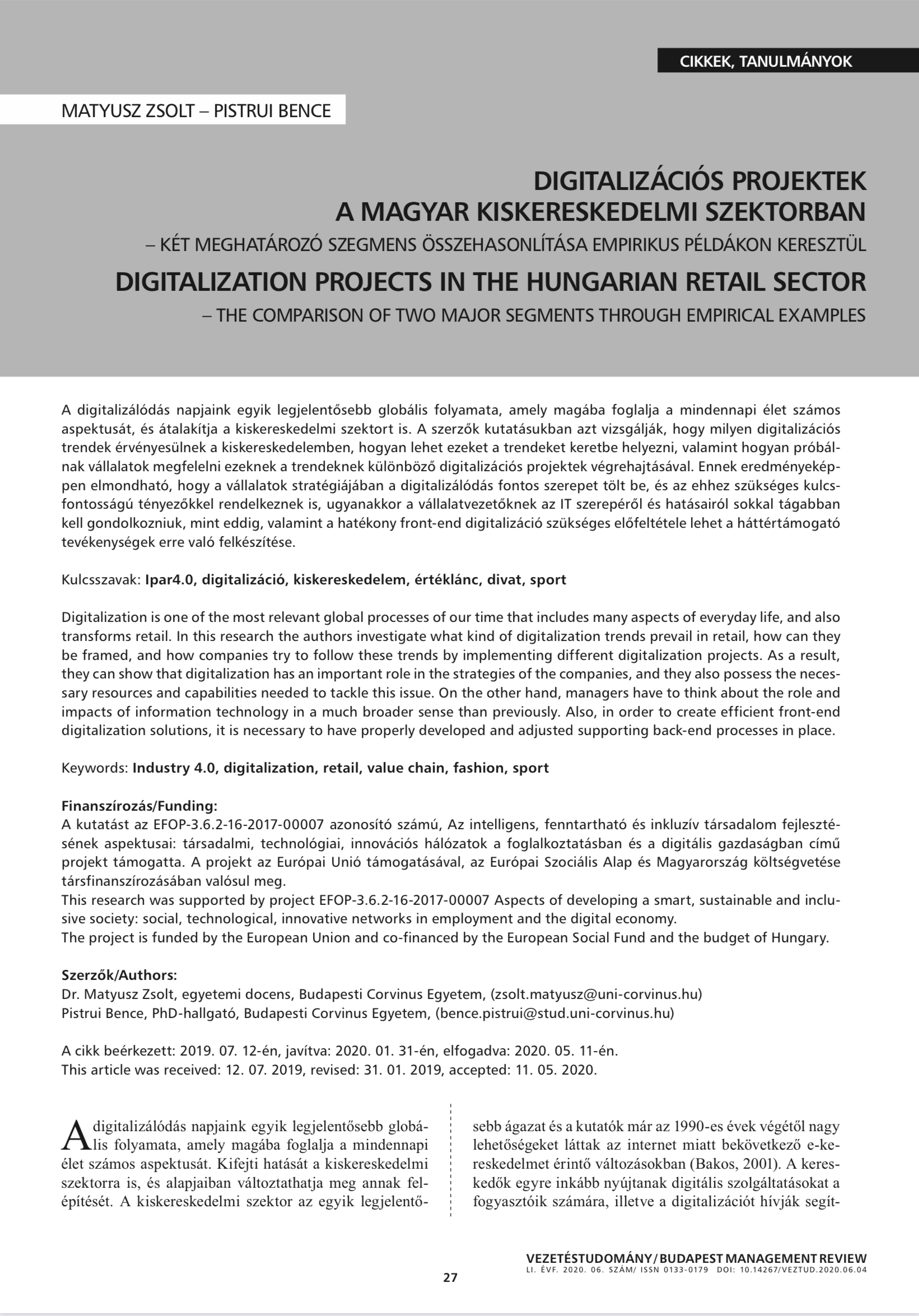Digitalizációs projektek a magyar kiskereskedelmi szektorban
Két meghatározó szegmens összehasonlítása empirikus példákon keresztül
DOI:
https://doi.org/10.14267/VEZTUD.2020.06.04Keywords:
Industry 4.0, digitalization, retail, value chain, fashion, sportAbstract
Digitalization is one of the most relevant global processes of our time that includes many aspects of everyday life, and also transforms retail. In this research the authors investigate what kind of digitalization trends prevail in retail, how can they be framed, and how companies try to follow these trends by implementing different digitalization projects. As a result, they can show that digitalization has an important role in the strategies of the companies, and they also possess the necessary resources and capabilities needed to tackle this issue. On the other hand, managers have to think about the role and impacts of information technology in a much broader sense than previously. Also, in order to create efficient front-end digitalization solutions, it is necessary to have properly developed and adjusted supporting back-end processes in place.
Downloads
References
Agárdi, I. (2018). A digitalizáció mint a kiskereskedelmi tevékenységet integráló tényező. Vezetéstudomány, 49(12), 50–57. https://doi.org/10.14267/veztud.2018.12.06
Bagdasarov, Z., Martin, A. A., & Buckley, M. R. (2020). Working with robots: Organizational considerations. Organizational Dynamics. https://doi.org/10.1016/j.orgdyn.2018.09.002
Bakos, Y. (2001). The Emerging Landscape for Retail E-Commerce. Journal of Economic Perspectives, 15(1), 69–80. https://pubs.aeaweb.org/doi/pdf/10.1257/jep.15.1.69
Bertacchini, F., Bilotta, E., & Pantano, P. (2017). Shopping with a robotic companion. Computers in Human Behavior, 77, 382-395. https://doi.org/10.1016/j.chb.2017.02.064
Bhave, A., Biggs, C., Burggraaff, P., Loftus, B., & Pathak, S. (2018): Accelerating Digital Innovation in Retail. The Boston Consulting Group. http://image-src.bcg.com/Images/BCG-Accelerating-Digital-Innovationin-Retail-June-2018_tcm21-194430.pdf
Bucsky, P. (2019). Megnyitották a magyar pénztárcákat a nemzetközi divatmárkák. https://g7.hu/vallalat/20190422/megnyitottak-a-magyarpenztarcakat-a-nemzetkozi-divatmarkak/
Deloitte (2017). Disruptions in Retail through Digital Transformation. Deloitte Touche Tohmatsu India LLP. https://www2.deloitte.com/content/dam/Deloitte/in/Documents/CIP/in-cip-disruptions-in-retail-noexp.pdf
DKFS (2017). Digitális kereskedelemfejlesztési stratégia. https://www.kormany.hu/download/c/88/f0000/Strat%C3%A9gia.pdf Letöltés dátuma: 2020.05.04.
Donnelly, C., & Wright, O. (2017). Painting Digital Future of Retail and Consumer. Accenture Strategy, 1–13.https://www.accenture.com/_acnmedia/PDF-52/Accenture-Strategy-DD-Painting-Digital-Future-POV-v2.pdf
Frey, C. B., & Osborne, M. A. (2017). The future of employment: How susceptible are jobs to computerisation? Technological Forecasting and Social Change, 114, 254-280. https://doi.org/10.1016/j.techfore.2016.08.019
Fuentes, C., Bäckström, K., & Svingstedt, A. (2017). Smartphones and the reconfiguration of retailscapes: Stores, shopping, and digitalization. Journal of Retailing and Consumer Services, 39, 270–278. https://doi.org/10.1016/j.jretconser.2017.08.006
Gartner Glossary (2020a). „Digitization”. https://www.gartner.com/en/information-technology/glossary/digitization
Gartner Glossary (2020b). „Digitalization”. https://www.gartner.com/en/information-technology/glossary/digitalization
GKI Digital (2020). Bruttó 625 milliárd forintért vásároltunk tavaly a hazai webáruházakból. https://gkidigital.hu/2020/03/11/brutto-625-milliard-forintert-vasaroltunk-tavaly-a-hazaiwebaruhazakbol/
Grewal, D., Ailawadi, K. L., Gauri, D., Hall, K., Kopalle, P., & Robertson, J. R. (2011). Innovations in retail pricing and promotions. Journal of Retailing, 87, S43–S52. https://doi.org/10.1016/j.jretai.2011.04.008
Hagberg, J., Sundstrom, M., & Egels-Zandén, N. (2016). The digitalization of retailing: an exploratory framework. International Journal of Retail & Distribution Management, 44(7), 694–712. https://doi.org/10.1108/IJRDM-09-2015-0140
Hagberg, J., Jonsson, A., & Egels-Zandén, N. (2017). Retail digitalization: Implications for physical stores. Journal of Retailing and Consumer Services, 39, 264–269. https://doi.org/10.1016/j.jretconser.2017.08.005
Hänninen, M., Smedlund, A., & Mitronen, L. (2018). Digitalization in retailing: multi-sided platforms as drivers of industry transformation. Baltic Journal of Management, 13(2), 152–168. https://doi.org/10.1108/BJM-04-2017-0109
Investopedia (2019). The World’s Top 10 Retailers. https://www.investopedia.com/articles/markets/122415/worlds-top-10-retailers-wmt-cost.asp
Keeling, K., Keeling, D., & McGoldrick, P. (2013). Retail relationships in a digital age. Journal of Business Research, 66(7), 847–855. https://doi.org/10.1016/j.jbusres.2011.06.010
KSH (2019a). Gyorstájékoztató. Kiskereskedelem, 2018. december, 2018. év (második becslés). http://www.ksh.hu/docs/hun/xftp/gyor/kis/kis1812.html
KSH (2019b). Digitális gazdaság és társadalom, 2018. http://www.ksh.hu/docs/hun/xftp/idoszaki/ikt/ikt18.pdf
KSH (2019c). A kiskereskedelmi üzletek forgalma üzlettípusonként. http://www.ksh.hu/docs/hun/xstadat/xstadat_eves/i_okfa007b.html
KSH (2019d). A kiskereskedelmi üzletek forgalma üzlettípusonként (2000–). http://www.ksh.hu/docs/hun/xstadat/xstadat_eves/i_okfa007b.html
KSH (2019e). A kiskereskedelmi eladási forgalom főbb árucsoportonként (korábbi módszertan alapján előállított adatok). https://www.ksh.hu/docs/hun/xstadat/xstadat_evkozi/e_okfb002c.html
Kumar, S. (2016). Transforming the Future of Retail with Robotics-As-A-Service (Abstract). May, 1–6. https://www.tcs.com/content/dam/tcs/pdf/Industries/Retaillogistics/Abstract/Transforming-the-Future-of-Retailwith-Robotics-As-A-Service.pdf
Lehdonvirta, V. (2012). A history of the digitalization of consumer culture: From Amazon through Pirate Bay to Farmville. In J. Denegriknot & M. Molesworth, (Eds.), Digital Virtual Consumption (pp. 11-29). London: Routledge.
Lu, L., Cai, R., & Gursoy, D. (2019). Developing and validating a service robot integration willingness scale. International Journal of Hospitality Management, 80, 36-51. https://doi.org/10.1016/j.ijhm.2019.01.005
Mäenpää, R., & Korhonen, J. J. (2015). Digitalization in retail: the impact on competition. In Collin, J., Hiekkannen, K., Korhonen, J.J, Halen, M., Itälä, T., & Helenius, M. (Eds.), IT Leadership in Transition. The Impact of Digitalization on Finnish Organizations (pp. 89-102). Helsinki: Aalto University.
Makridakis, S. (2017). The forthcoming Artificial Intelligence (AI) revolution: Its impact on society and firms. Futures, 90, 46-60. https://doi.org/10.1016/j.futures.2017.03.006
Merriam-Webster (2020). „Digitalization”. https://www.merriam-webster.com/dictionary/digitalization
Pantano, E., & Vannucci, V. (2019). Who is innovating? An exploratory research of digital technologies diffusion in retail industry. Journal of Retailing and Consumer Services, 49, 297-304. https://doi.org/10.1016/j.jretconser.2019.01.019
Porter, M. E. (1985). Competitive Advantage. New York, USA: The Free Press.
Priporas, C. V., Stylos, N., & Fotiadis, A. K. (2017). Generation Z consumers’ expectations of interactions in smart retailing: A future agenda. Computers in Human Behavior, 77, 374-381. https://doi.org/10.1016/j.chb.2017.01.058
PwC (2016a). Opportunities and challenges for consumer product and retail companies. PwC. https://www.strategyand.pwc.com/media/file/Industry-4-0-RC.pdf
PwC (2016b). What if the store had a voice? PwC Digital Services. https://digital.pwc.com/content/dam/pwcdigital/US/FeaturedVideos/Abstracts/VID_RET_Abstract.pdf
Strange, R., & Zucchella, A. (2017). Industry 4.0, global value chains and international business. Multinational Business Review, 25(3), 174-184. https://doi.org/10.1108/MBR-05-2017-0028
Shankar, V. (2018). How Artificial Intelligence (AI) is Reshaping Retailing. Journal of Retailing, 94(4), vi–xi. https://doi.org/10.1016/S0022-4359(18)30076-9
Soutjis, B., Cochoy, F., & Hagberg, J. (2017). An ethnography of Electronic Shelf Labels: The resisted digitalization of prices in contemporary supermarkets. Journal of Retailing and Consumer Services, 39, 296–304. https://doi.org/10.1016/j.jretconser.2017.08.009
Statista (2019a). Number of retail chains in Hungary in 2018, by sector. https://www.statista.com/statistics/642255/retail-chains-number-by-sector-hungary/
Statista (2019b). Sports & Outdoor Hungary. https://www.statista.com/outlook/259/139/sports-outdoor/hungary?currency=eur#market-revenue
Verhoef, P. C., Kannan, P. K., & Inman, J. J. (2015). From Multi-Channel Retailing to Omni-Channel Retailing. Introduction to the Special Issue on Multi-Channel Retailing. Journal of Retailing, 91(2), 174–181. https://doi.org/10.1016/j.jretai.2015.02.005
Willems, K., Smolders, A., Brengman, M., Luyten, K., & Schöning, J. (2017). The path-to-purchase is paved with digital opportunities: An inventory of shopper-oriented retail technologies. Technological Forecasting and Social Change, 124, 228–242. https://doi.org/10.1016/j.techfore.2016.10.066

Downloads
Published
How to Cite
Issue
Section
License
Authors assign copyright to Vezetéstudomány / Budapest Management Review. Authors are responsible for permission to reproduce copyright material from other sources.

